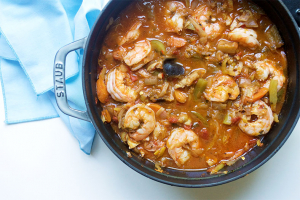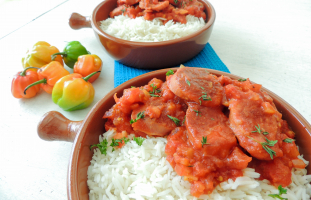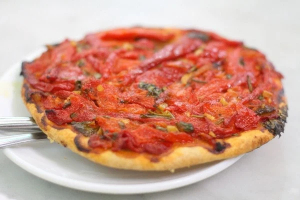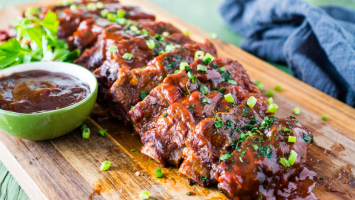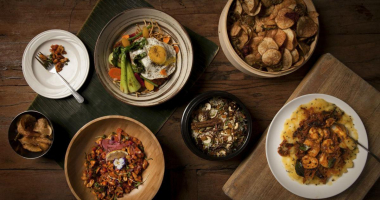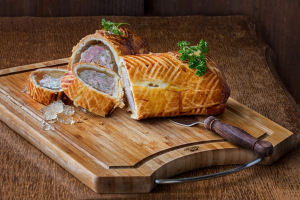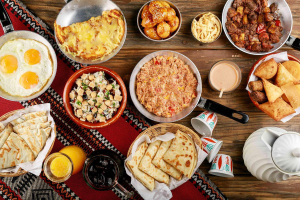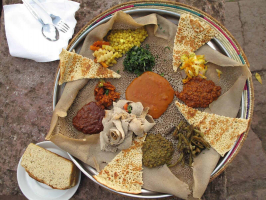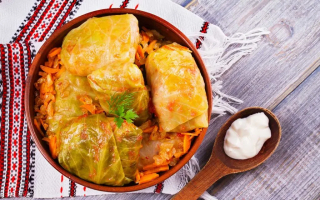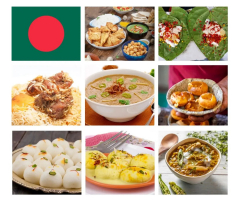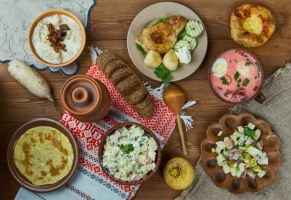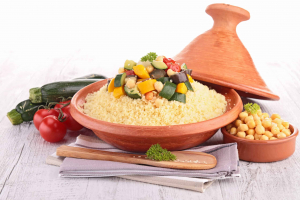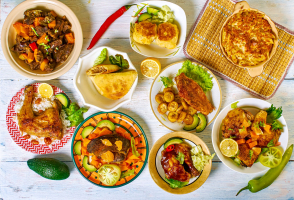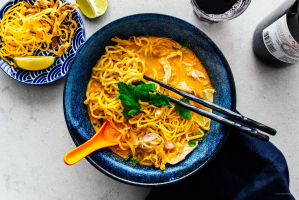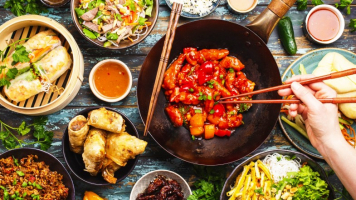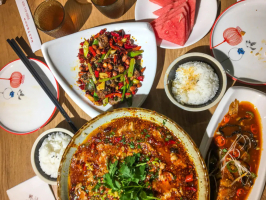Top 10 Best Foods In Lesotho With Recipe
Lesotho is a small country in Southern Africa that covers around 30,350 square kilometers. Lesotho's people are renowned to be quite tranquil and quiet, and ... read more...they live a very basic existence. Their straightforward nature is reflected in their recipes, which are frequently practical and straightforward, with few ingredients, basic cooking methods, and no spices. Discover the list of top 10 best foods in Lesotho with recipe that you should not miss.
-
Magwinya, commonly known as fat cakes in Tswana, requires no introduction. To the rest of the world, this is what makes millions of people in Botswana and South Africa happy. It's the kind of cuisine that brings back memories of home, of mama's kitchen, or of the auntie (ausi) at the semausu (the corner shop or street vendor stand). For some, this deep-fried South African doughnut evokes childhood memories.
It is found not only in Botswana and South Africa, but throughout most of Africa. They are known as mafatcooks or fetcooks in Zimbabwe and Malawi. In West Africa, it is known as puff puff in Nigeria and bofrot in Ghana. In Kenya, a version is known as mandazi, and a variant is known as mahamri. These fried balls, whatever you name them, are puffy, crispy, and pleasantly sweet.
Magwinya is eaten with polony in South African townships (similar to bologna). High school students in Botswana love the incredibly unhealthy mix of magwinya and fried potato chips. Serve them hot out of the fryer for breakfast, a sweet snack, or dessert. They're also a good party snack.
Ingredients
- 2 cups all-purpose flour, 2 teaspoons instant yeast, 4 tablespoons white sugar, 1/2 teaspoon salt, 1 tablespoon vegetable oil (plus more for frying), 2 cups warm water
Instructions
- In a large mixing bowl, combine the dry ingredients: flour, sugar, yeast, and salt. Mix well.
- Add the water and 1 tablespoon of vegetable oil and mix into a soft dough.
- Cover the mixture with a tea towel and allow to rise for about one hour. The dough should roughly double in size.
- Mix further and let the dough rest for 10 minutes.
- Heat a large pot of vegetable oil over a medium flame for deep frying. Test the temperature of the oil by dropping a little batter in. If it sizzles, you’re ready to start frying.
- With a tablespoon, add dollops of dough into the oil, using a second spoon to help push the dough down if necessary. Make sure you turn them frequently until golden brown.
- Drain over paper towels and serve whilst they are warm.
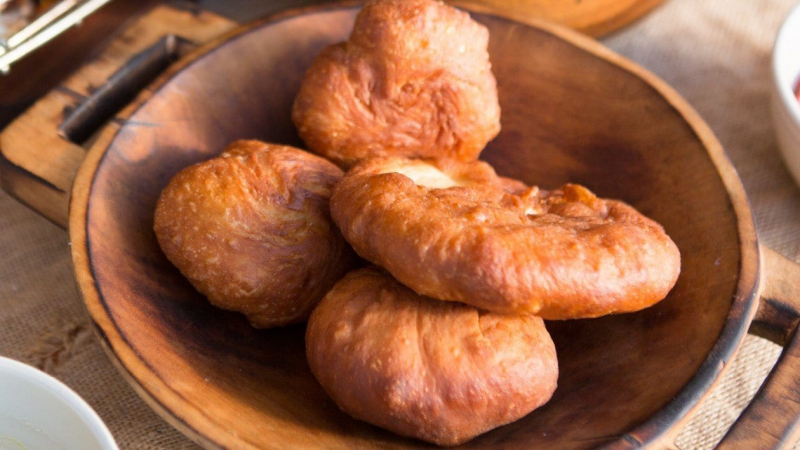
unileverfoodsolutions.co.za 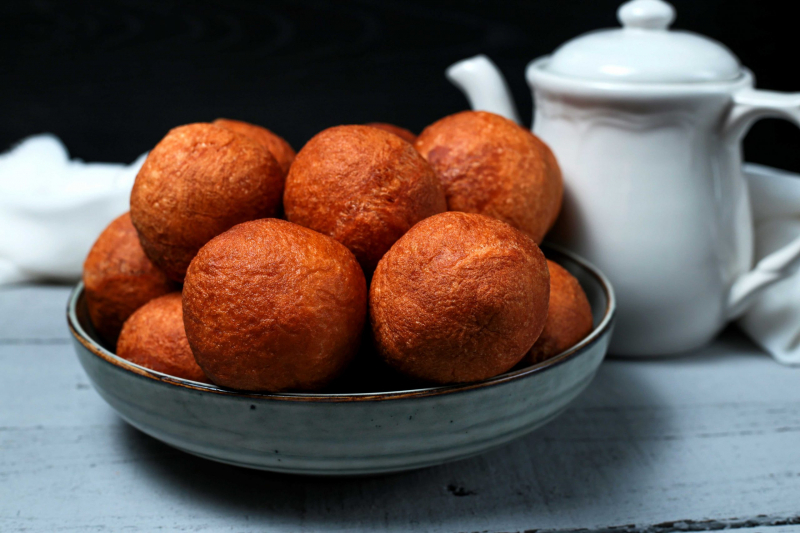
food-vows.com -
Grilling meat is practically the South African national sport, crossing lines of wealth, geography and even race. Braai means grill in Afrikaans, and some say it’s the only word recognized in all of the country’s 11 official languages. When friends or family get together in Lesotho, a braai is a traditional feast. A braai can be used to prepare almost anything, including meat, wors (a South African sausage), fish, garlic rolls, and more.
It is typically served with papa and chakalaka (a spicy South African vegetable relish) and beer in Lesotho. Meat is spiced or marinated before being grilled over a wood or coal fire, while fish is spiced before being wrapped in aluminum foil and roasted over a fire. Street sellers also sell meat roasted over a wood fire. It comes with papa and moroho. It is the most popular lunch option for all workers and anyone looking for a delicious meal that isn't fast food.
Ingredients
- 4 tablespoons coarse salt, 2 tablespoons white or brown sugar (optional), 2 tablespoons coriander seeds, 1 tablespoon black peppercorns, 1 tablespoon paprika or 2 teaspoons paprika plus 1 teaspoon cayenne, 1 tablespoon garlic flakes or powder, 1 tablespoon onion powder, 1 tablespoon dried thyme, 4 to 6T-bone steaks, about 1½ inches thick
Instructions
- Make the braai spice: In a grinder or mortar and pestle, grind all the seasonings and herbs until fine.
- Rub steaks with the braai spice and set aside in refrigerator for 1 to 4 hours. Bring to room temperature before grilling.
- Heat a grill until screaming hot.
- Place steaks on the grill and cook, turning every 2 minutes or so, until crusty outside and medium-rare inside, 120 to 125 degrees.
- Let rest 10 minutes and slice across the grain for serving.
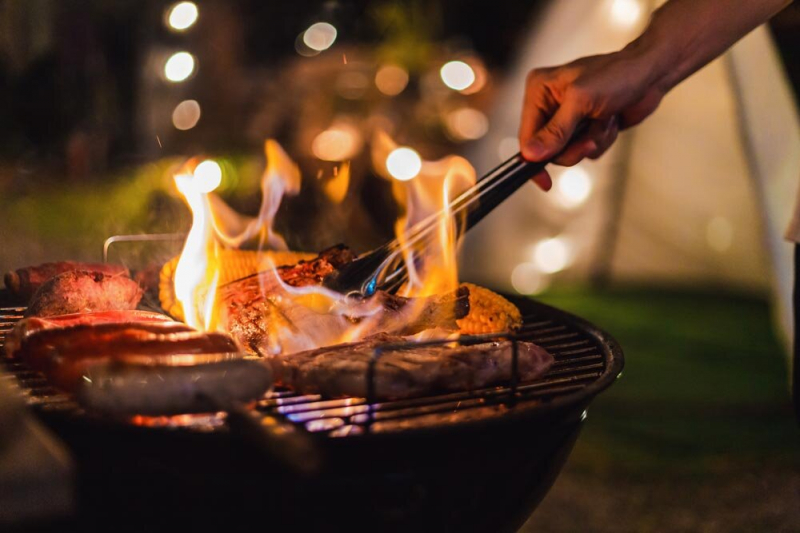
ulj.co.nz 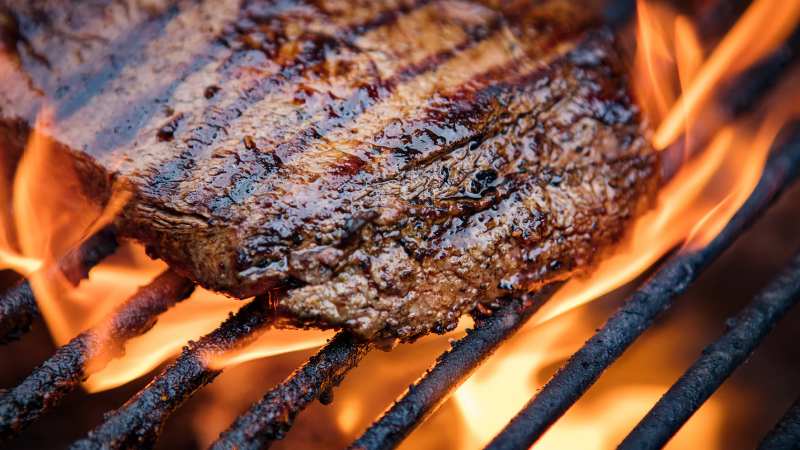
megamaster.co.za -
Samp ranks 3rd in the list of the best foods in Lesotho with recipe. Samp is made from dried maize kernels that have been crushed and chopped until broken, but not as coarsely as maize meal. The outer layer of the kernels is removed throughout the process, leaving behind the sensitive inner layer. Samp is typically prepared at various events or festivals, as well as in households throughout the winter.
It is typically cooked in the Highlands by simply cooking it until mushy and seasoned with salt. It is also combined with beans, cooked, and seasoned with salt. The same recipe is utilized in the lowlands, but the seasoning has been changed in most houses and gatherings. You still boil it till it's soft, but when it's almost done, you season it with stuff like Aromat, Rama margarine, coffee creamer, cream of mushroom soup, cream of chicken soup, and more. It goes well with stew or other meat and vegetables.
Ingredients
- 500 ml samp (410g), SPAR canola or sunflower oil, 1 large onion, finely chopped, 3 large cloves garlic, chopped, 3 small rainbow peppers, finely chopped, 200 g punnet button mushrooms, finely chopped, 1 medium brinjal, finely chopped (unpeeled), 1 large red chilli, finely chopped, 410g can SPAR diced tomato, 1 bunch fresh dhania, rinsed and leaves chopped, 410g can cooked sugar beans, drained, 250g SPAR grated cheddar cheese (500 ml)
Instructions
- Cover the samp with lots of water, in a 3 litre SPAR Good Living porcelain mixing bowl. Set aside to soak for at least 8 hours.
- Pour generous amount of salted boiling water over the soaking samp, and cook for 1 hour in a microwave oven, until tender and all the water is absorbed. (Drain in a colander only if necessary)
- Lightly fry the onion, garlic, peppers, mushroom, brinjal and chilli together in a little oil. Add the tomato and dhania, and simmer until the liquid reduces considerably. Season generously to taste. Stir in the sugar beans.
- Combine this mixture with the cooked samp. Cover and keep warm.
- Just before serving, add in the cheese to melt in the heat of the samp.
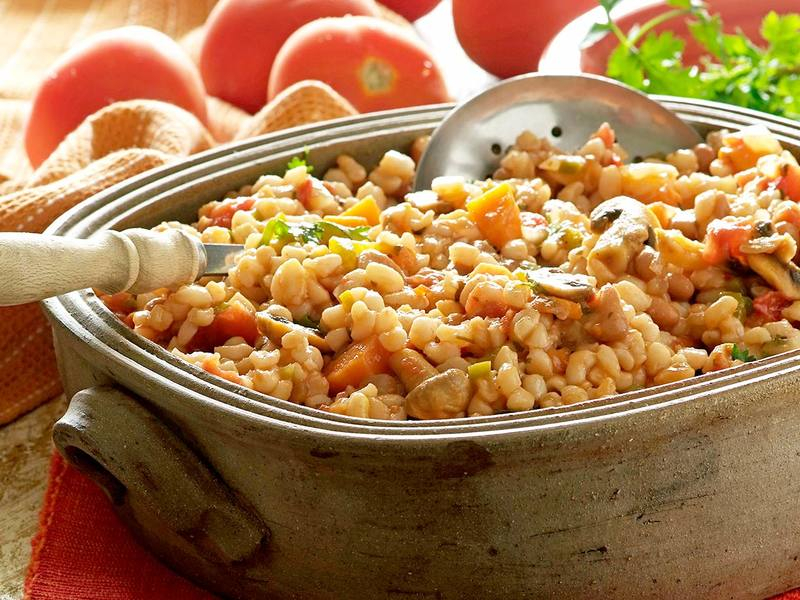
whatsfordinner.co.za 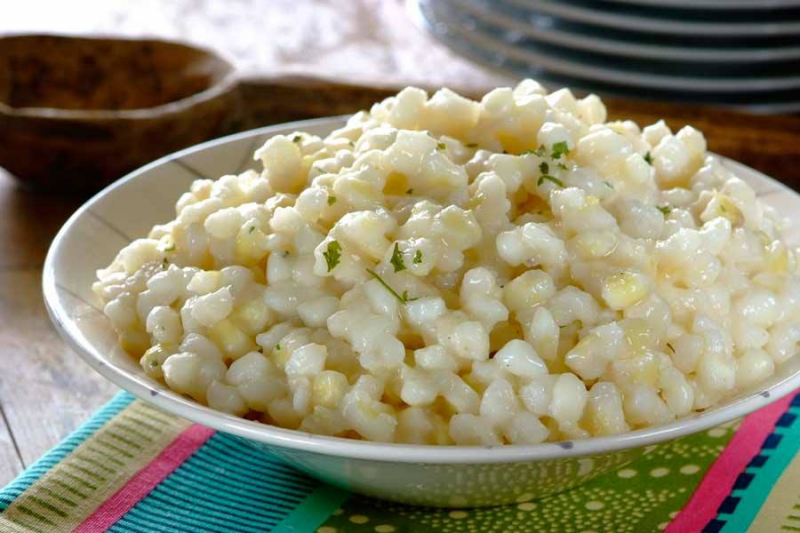
whatsfordinner.co.za -
In Lesotho, papa is a staple food that is eaten by practically every household. Maize is carried to a local mill in the highlands and ground into maize meal or mealie meal, which differs in color and taste from that used in the lowlands, which is more refined and store-bought.
Bring water to a boil in a pot, then add the maize meal and stir with a stick called a lesokoana until it has a thick consistency, then reduce the heat. After a few minutes, stir the papa again in a procedure called ho e fetola, which means "to turn it," and your papa should be more solid. After a few minutes, stir the papa again for the final turn, and your papa is ready. It is typically served with moroho (leafy greens), and papa ka moroho is a common dinner in Lesotho. Serve papa ka moroho with meat, canned fish, eggs, or other protein of your choosing for a more balanced meal. You can also serve it with fresh or sour milk, as well as your favorite beans, peas, or veggies.
Ingredients
- 1 1⁄4cups white cornmeal, 1cup milk, 1cup water
Instructions
- Heat a cup of water to boiling in a medium-sized saucepan.
- Meanwhile, in a bowl gradually add 3/4 cup of the cornmeal to the milk, stirring briskly to make a smooth paste.
- Add this mixture to the boiling water, stirring constantly.
- Cook for 4 or 5 minutes while adding the remaining cornmeal.
- When mixture begins to pull away from the sides of the pot and stick together, remove from heat.
- Dump oshifima into a lightly greased bowl.
- With damp hands, shape it into a smooth ball, turning in the bowl to help smooth it.
- Serve immediately.
- To eat in the traditional manner, tear off a piece of oshifima and make an indentation in it with your thumb. Use this hollow to scoop up stew or sauce from a communal bowl.
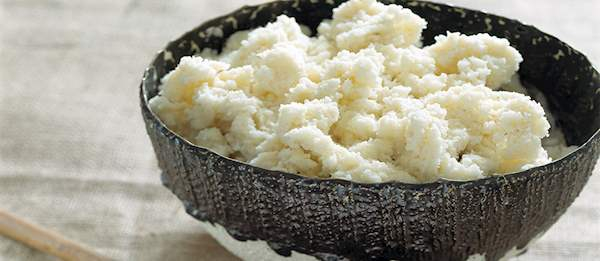
tasteatlas.com 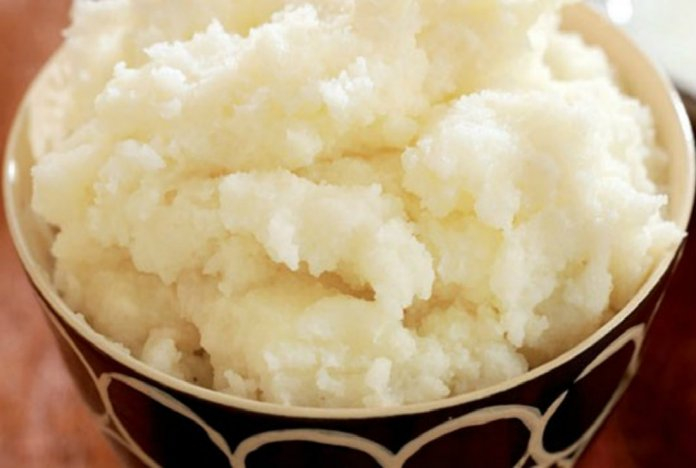
whaleshares.io -
Nyekoe ranks 5th in the list of the best foods in Lesotho with recipe. Nyekoe is a Lesotho-based traditional African cuisine. Beans, sorghum, pumpkin, oil, salt, and pepper are used to make it. After soaking the beans overnight, they are boiled with sorghum, and small bits of pumpkin are added to the saucepan with the other ingredients. Oil and seasonings are also added to the saucepan, and the mixture is mashed slightly to the proper consistency. This vegetarian stew can be eaten hot or cold and is typically prepared in big black cauldrons throughout the winter.
To make this dish, boil the sorghum in water and then add the beans. Cook until both the sorghum and the beans are tender, then season with salt. There are numerous nyekoe recipes. Some people eat it alone, while others add chopped pumpkin or wheat to the sorghum and beans. It's usually sold by street sellers rather than prepared at home.
Ingredients
- 250g sugar beans — dried, water 500ml, rice — corn 60g margarine, salt and freshly ground black pepper — to taste
Instructions
- Place sugar beans in a bowl and cover completely with water. Allow to soak overnight.
- In another saucepan bring water to the boil and cook drained beans for one hour.
- Add corn rice, top up with water if necessary, cook gently for one more hour.
- Stir in fat, season with salt and pepper.
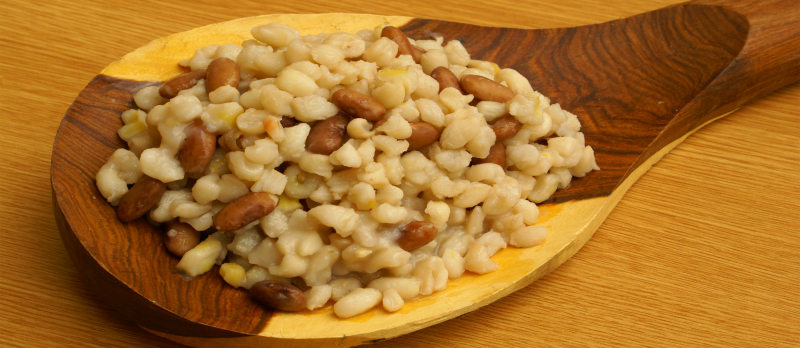
tasteatlas.com 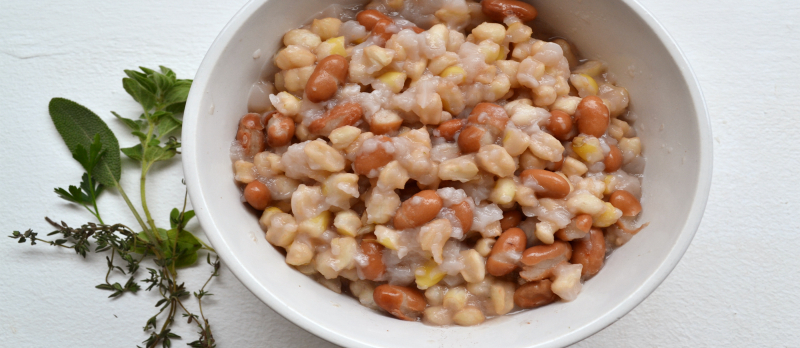
tasteatlas.com -
Referring to the delicious food in Lesotho, one cannot forget the Roasted Chicken Feet and Gizzards Kebabs. This is a dish with simple ingredients but very easy to make. Gizzards with attached liver are sometimes sold alongside dressed chicken. Frozen gizzards are sold individually in wet markets and most supermarkets in the Philippines as a delicacy. Gizzards are quite tough. Really difficult. To make chicken gizzard appealing to humans, it must be thoroughly cleaned and cooked. Gizzards cannot be tenderized simply by threading them on bamboo skewers and cooking them directly.
The preferable method is to marinate the gizzards before grilling them over live coals. This allows the gizzards to absorb the marinade's flavors and the meat fibers to break apart. And because the gizzards are fully cooked, grilling time is only around 8 minutes. That's all it takes to add texture and smokey taste. Although simple, this dish will attract you from the first bite.
Ingredients
- 500 grams chicken gizzards, ½ cup vinegar, 2 teaspoons salt, ½ teaspoon peppercorns, 1 half-inch knob ginger, 2 cloves garlic, 1 shallot, 1 bay leaf
Instructions
- Rinse the gizzards well. Inspect each and every one. Pull out and discard any fatty tissues attached to them–especially all yellowish grainy bits attached to them.
- When you’ve removed all the nasty bits from the gizzards, rinse them again then drain.
- Place them in a non-reactive bowl and pour the vinegar over them.
- Leave them there for 10 minutes then rinse again. Discard the vinegar.
- Place the now clean gizzards in a pot and add enough water to cover.
- Add the salt, peppercorns, ginger, garlic, shallot and bay leaf.
- Bring to the boil, lower the heat, cover and simmer for an hour to an hour and a half depending on how large the gizzards are. If the liquid dries out before the gizzards are done, just add a cup of water each time.
- While the gizzards simmer, soak the bamboo skewers in water. This will prevent them from catching fire on the grill.
- When the gizzards are done, drain and cool.
- When cool enough to handle, if they are rather large, you may cut them into bite-size pieces. It’s optional, really, because they are very tender at this point and tearing them with your teeth should be a breeze.
- Preheat your grill. High heat will be necessary. The gizzards will be on the grill only for a short time and you really want the heat to lick as much of their surface with gusto.
- Thread a few pieces of gizzard in each bamboo skewer. Repeat until all the gizzards have been skewered.
- In a bowl, mix together all the ingredients for the basting sauce.
- Brush the gizzards all over with the sauce.
- Grill the gizzards over intensely high heat. Just two minutes or so per side. You may baste them a few times during grilling. How brown and scorched you want them is entirely up to you. Remember though that the basting sauce contains honey and that burns fast.
- Serve the chicken gizzards right off the grill.
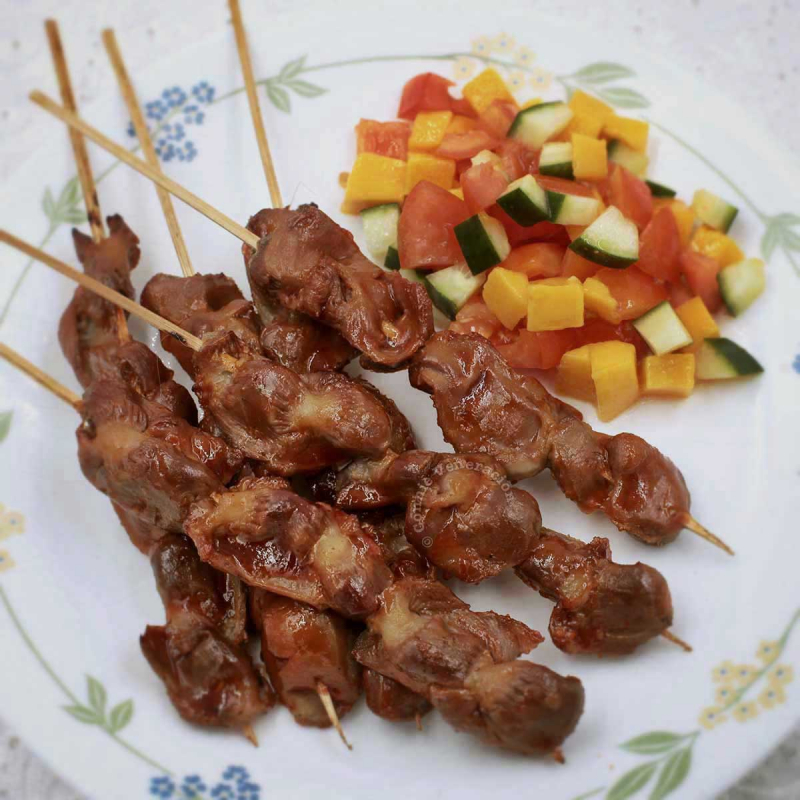
umamidays.com 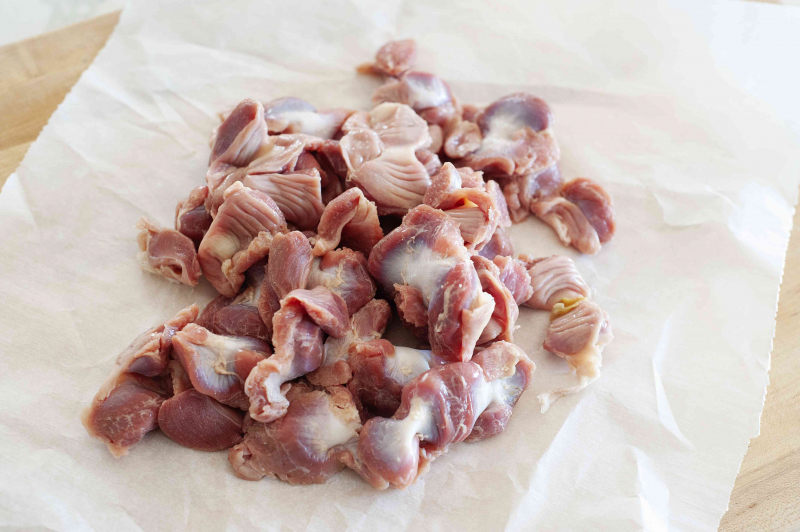
simplyrecipes.com -
There are many different types of sausages on the market today, but surely Boerewors will give you a completely different taste from other sausages. Boerewors is a coarse-ground sausage, therefore it has a chunky and coarse texture rather than the fine and silky texture of, instance, a German wurst. There are two kinds of wors: those that are supposed to be cooked in a pot or saucepan on the stove and those that are meant to be braaied. For the stovetop wors, various recipes are used. Some prepare it plain, while others add tomato relish and other things. It is traditionally served with papa, but it can also be eaten with rice, samp, pasta, or bread.
Boerewors seasoning is distinguished by the presence of coriander, black pepper, nutmeg, and allspice, as well as a dark vinegar (malt vinegar). The vinegar and salt both preserve the sausages and provide taste. This combination of spices and vinegar produces a distinct flavor that is distinctive to South African cuisine.
Ingredients
- 2 lb beef roast, (top round roast or brisket), trimmed of sinew, 1 lb fatty pork shoulder/butt, or pork neck or belly, 1 Tbsp ground coriander seeds, 1 Tbsp salt, ½ tsp ground allspice, ½ tsp ground black pepper, ¼ tsp ground nutmeg, 1/8 tsp ground cloves, ¼ c malt vinegar, hog casing for fresh sausage
Instructions
- Preparing the Meat
- Cube the beef and pork into pieces that will fit easily into your meat grinder. Sprinkle the spices over meat and mix to coat. Cover the seasoned meat and refrigerate for at least 1 hour.
- After the meat has rested, follow the instructions that came with your meat grinder to grind the seasoned meat using the coarse grinding blade.*
- Add the vinegar to the ground meat and mix well.
- Stuffing the Sausage
- Thoroughly rinse (inside and out) one salted hog casing. Prepare the casing for stuffing as directed on the casing package.
- If using a Kitchen Aid, or similar, mixer, attach the thick sausage stuffer attachment to the meat grinder attachment.
- Place the entire casing onto the sausage stuffer attachment, leaving 4 inches hanging off the end. Tie a knot in this end of the casing to keep your sausage mixture from oozing out. Begin to stuff your casing as directed for your machine, moving slowly and being careful not to over-stuff the casing.
- As you stuff the casing, coil the sausage onto a large plate. Stop stuffing when you only have 5-6 inches of casing left. Remove the casing from the sausage stuffer attachment.
- Before you knot the end, check the sausage for uneven areas. If you find any, gently even out the sausage mixture in the casing with your hands.
- Once the sausage is even to your liking, knot the end of the casing.
- If you still have additional sausage mixture (for us, this recipe made two 1.5 lb sausages), rinse and prepare another casing and stuff it as before.
- Once all your sausage mixture has been stuffed, refrigerate your sausages overnight (at least 12 hours) so that the flavors can come together before cooking.
- Cooking the Sausage
- The traditional way to cook boerewors is on the grill. Heat your grill to a medium-high heat (400F). (You should be able to hold your hand a few inches from the cooking grate for 4-5 seconds.) If desired, soak a large wooden skewer or two in water. Place the skewers through the sides of the sausage coil to make it easier to turn the sausage when it’s on the grill. If you like a little grilling adventure, cook the sausage coil loose.
- Place the boerewors onto the grill and cook for 4-5 minutes on the first side, until the color has changed and the sausage has nice grill marks. Flip the boerewors and cook for 3-4 minutes on the second side, until the sausage is firm.
- Remove the sausage from the grill and place on a large platter to serve.
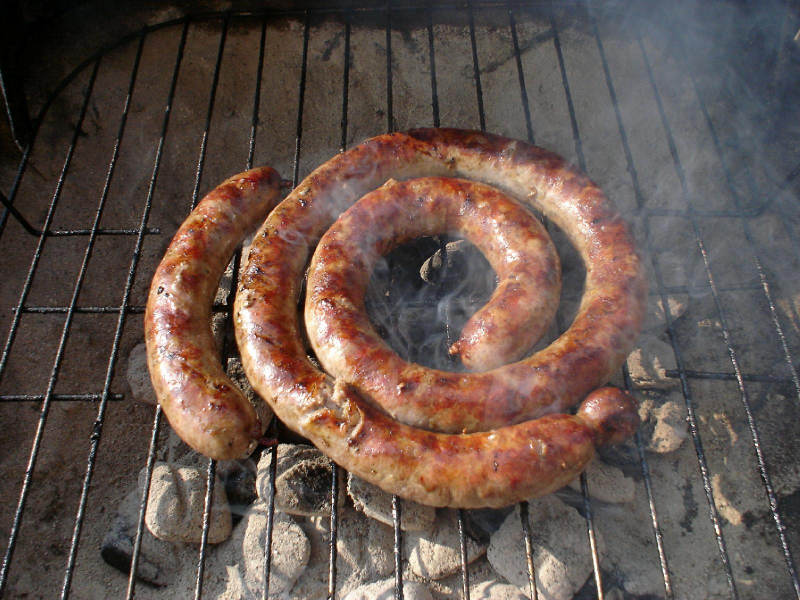
food.com 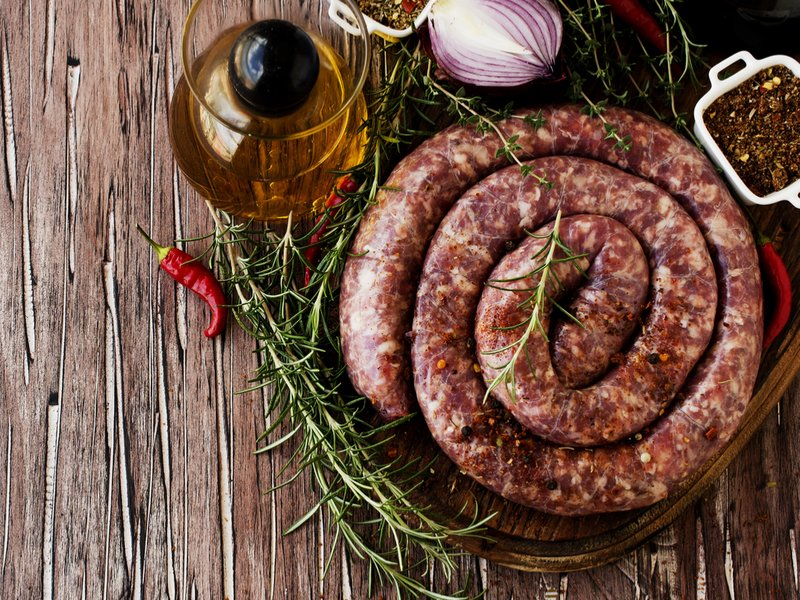
slaghuis.co.uk -
Diphaphatha ranks 8th in the list of the best foods in Lesotho with recipe. Diphaphatha or Phaphatha is a flattened bread like muffin that is cooked through stove top. This flatten Botswana dish calls for easy ingredients which is easily available in their pantry. The shape of the phaphatha is flat and circular and it is cooked in a frying pan without any fat.
Diphaphatha is usually consumed at breakfast or as a snack. Since this dish is are not flavoured with any herbs or spices, it’s usually served along with a protein stew. Locals enjoy a hot cup of tea or coffee with fresh warm phaphatha stuffed with chicken liver or chicken stew at 10am in the morning. Although it is essentially a quite filling snack which can be served with a jam or salted butter. They just enjoyed having this flatbreads with nutella, these Diphaphatha are quite filling and satisfying to finish a breakfast easily with your favourite spreads or sauces.
Ingredients
- 3 cups bread flour, 1½ tsp salt, 1½ cups water lukewarm, 1 tsp active yeast, 1 tbsp vegetable oil
Instructions
- Mix together the dry ingredients.
- Add water little by little and knead.
- Cover the ball of dough and leave in a warm place for 6 - 8 hours to rise to twice its size.
- Preheat oven to 350°F/180°C
- Work on a surface that you've strewn with flour.
- Knead down the bread and form into a dough.
- Brush with oil and place in a large pot. Put on a lid.
- Bake for about 50 minutes. Lid may be removed for the last 10 minutes to brown the bread on top.
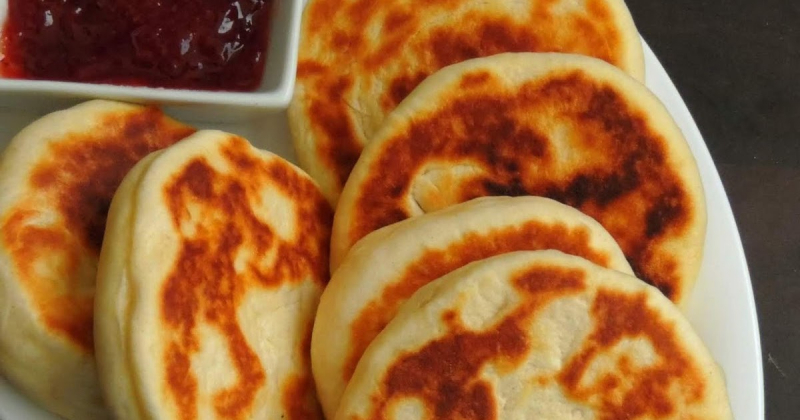
thecozyapron.com 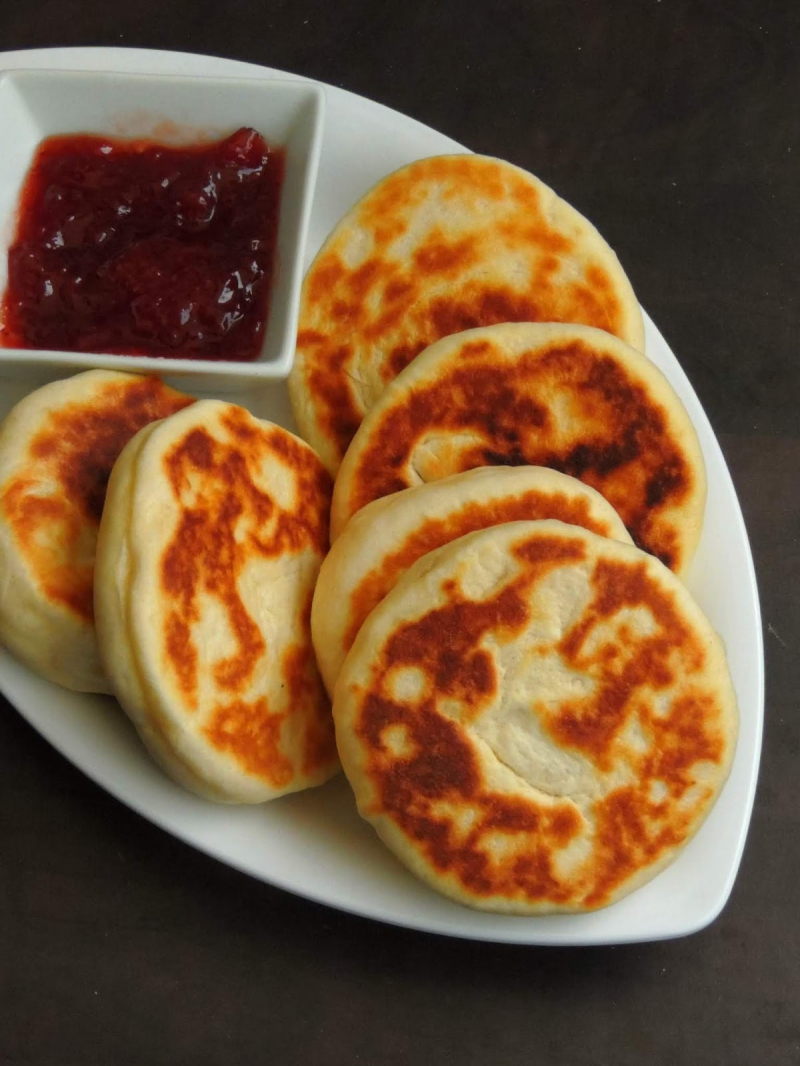
thecozyapron.com -
Fish is considered a luxury in Lesotho since Basotho consume more meat than fish. With its high omega-3 fatty acid content and minimal mercury concentration, trout is one of Lesotho's best fish. Trout can be grilled, smoked, or grilled to perfection! It's a versatile fish with delicious outcomes. Trout fillets are usually pretty thin which makes them perfect for cooking on stove top in a skillet. One of the best trout recipes they've tried is simply cooking the trout in the skillet in olive oil, and then adding garlic, lemon juice, white wine, fresh parsley and butter. Bake for a few minutes at 180°C in a preheated oven. They are frequently served with veggies and rice.
Another simple way to cook Trout is simply to enhance it with capers, garlic, lemon and butter. You combined just those ingredients to make this easy and delicious Trout with Caper-Garlic Lemon Butter Sauce. You can use steelhead trout or regular trout for this recipe.Ingredients
- 5 pounds trout or salmon, or arctic char - 2 large fish fillets with skin on the bottom,2 tablespoons olive oil more, if needed, 1 tablespoon Italian seasoning (dried thyme, oregano, parsley, combined together), ¼ teaspoon salt to taste, 4 garlic cloves diced, 3 tablespoons lemon juice freshly squeezed, 2 tablespoons white wine, 2 tablespoons butter softened, 2 tablespoons parsley chopped
Instructions
- Season the top of fish fillets with Italian herb seasoning and salt (generously). Fish fillets will have skins on the bottom - no need to season the skins.
- In a large skillet (large enough to fit 2 fish fillets), heat 2 tablespoons of olive oil on medium heat until heated but not smoking. To the hot skillet with olive oil, add fish fillets skin side up - flesh side down. Cook the flesh side of the fish for about 3-5 minutes on medium heat, making sure the oil does not smoke, until lightly browned.
- Flip the fillets over to the other side, skin side down (add more oil, if needed). Cook for another 2-4 minutes on medium heat (to prevent oil from burning).
- Remove the skillet from heat, close with the lid, and let the fish sit for 5-10 minutes, covered, in the skillet, until flaky and cooked through completely.
- After the fish is cooked through, off heat, using spatula, carefully remove fillets to the plate, separating the fish from the skin. Carefully remove or scrape the fish skin off the bottom of the pan, making sure to leave all the cooking oils in the pan.
- Add diced garlic, lemon juice, and white wine to the same pan with oil. Cook on medium-low heat for about 1 minute, until garlic softens a bit. Remove from heat. Add 1 tablespoon of chopped parsley, and 2 tablespoons of butter, off heat, to the sauce, stirring, until the butter melts and forms a creamy mixture.
- Add fish to the pan, spoon sauce over the fish, top the fish and sauce with the remaining 1 tablespoon of parsley, and serve.
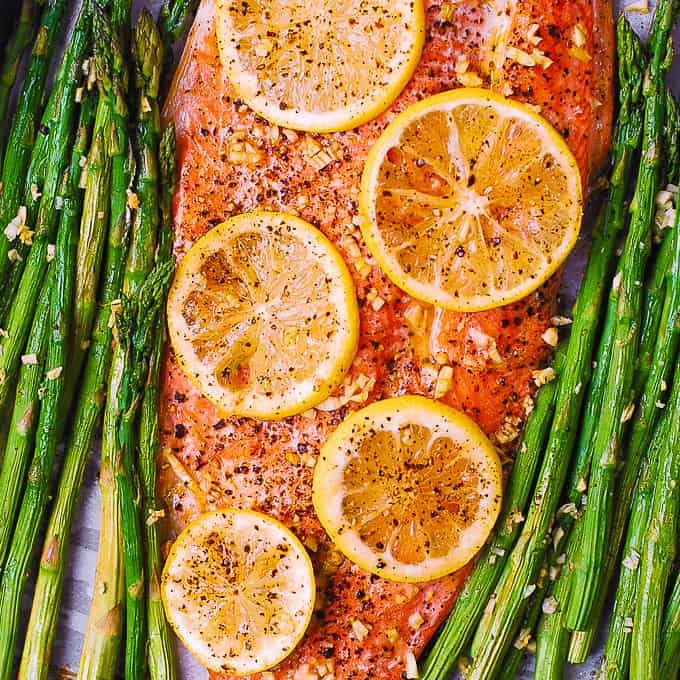
juliasalbum.com 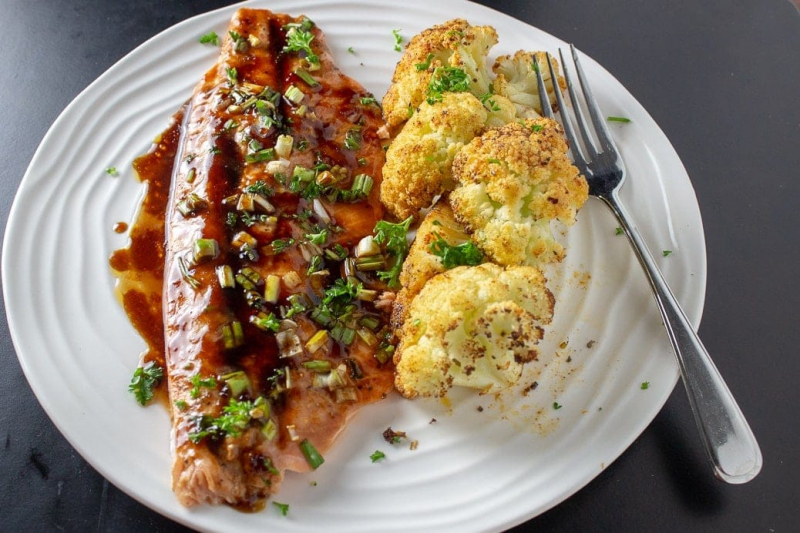
twokooksinthekitchen.com -
Morogo or Moroho, often known as African spinach, refers to a set of at least three different dark green leafy vegetables grown for human use throughout Southern Africa (cowpea, vegetable amaranth, and spider blossom). It is a traditional South African meal that is an integral part of the staple diet in rural communities.
Although moroho is not made from maize, it must be served next to papa since that is where it belongs. Moroho isn't complete without papa. Moroho is prepared from leafy greens like spinach and rape. Some weeds, such as white geese, and plants, such as stinging needle, are also consumed as moroho. Cabbage can also be used to make moroho.
Lepu is the most popular moroho (summer squash leaves with young small squash). Remove the little thorns and wash the leaves. Place the leaves in a pot after cutting them. Then dice the squash (no need to remove the seeds because they are still quite soft) and add it to the chopped leaves. Cook till soft in oil with just a pinch of salt. Some people add chopped spring onions for taste and scent.
Ingredients
- 2-3 tbsps oil, 1 fresh red chilli, chopped finely, or 1/2 tsp dried chilli flakes, 1 small red or white onion, 150 ml vegetable stock, Soy sauce
Instructions
- Saute the onion and chilli in the oil on moderate heat until they are soft.
- Then add the greens, and stir-fry for 1-2 minutes until they start to wilt and become glossy with oil.
- Add the vegetable stock, stir, and clamp on a lid for another 2-3 minutes (make sure it doesn’t burn, keep an eye and stir and/or turn down the heat if you need to).
- Finish the moroho with a shake or several of soy sauce.
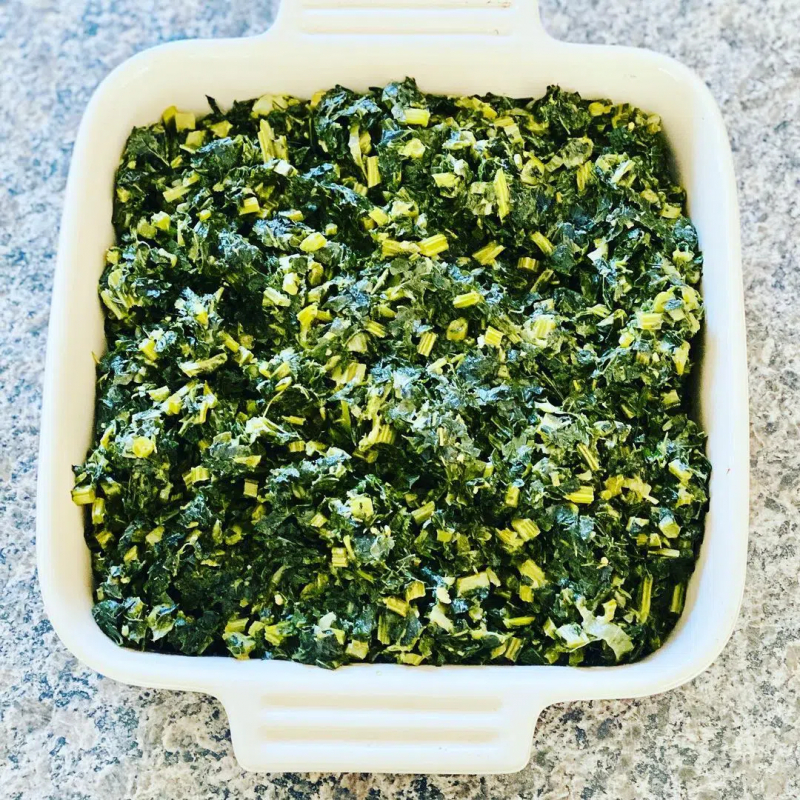
chefspencil.com












